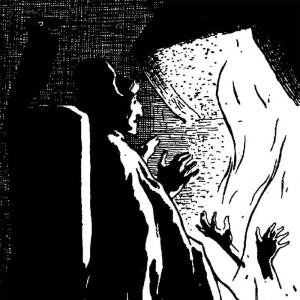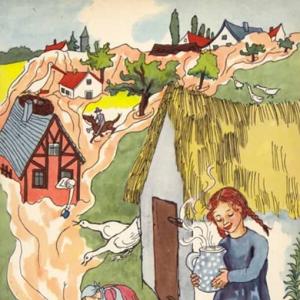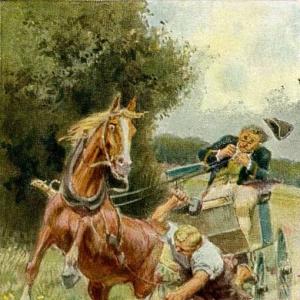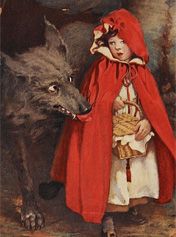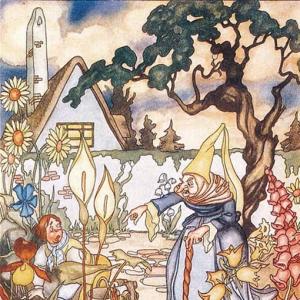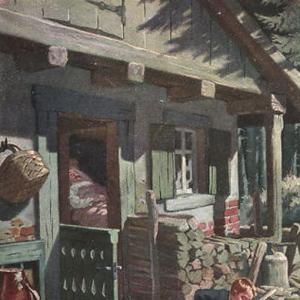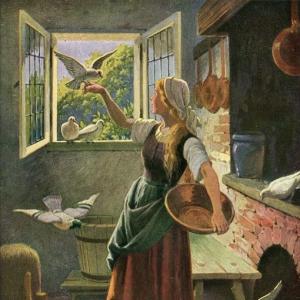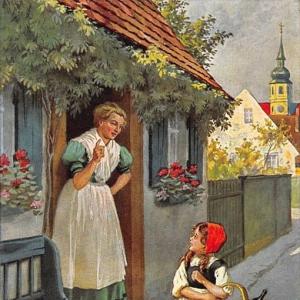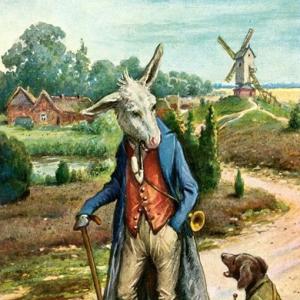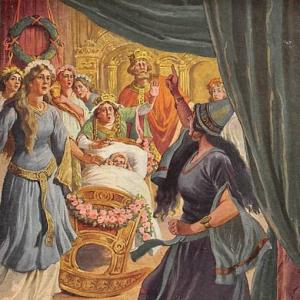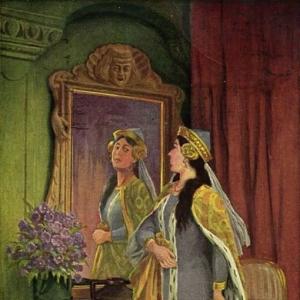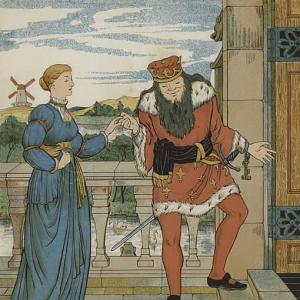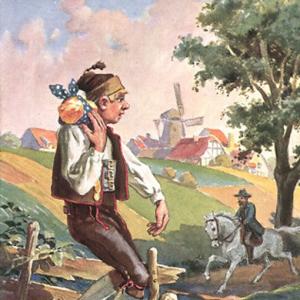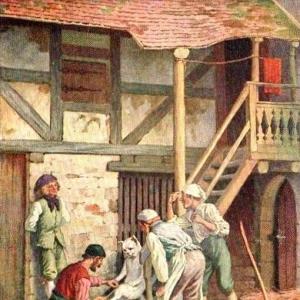Reading time: 11 min
In olden days, when grandfather was just a little boy and wore red trousers, a red jacket, a sash around his waist, and a feather in his cap – for that’s the way little boys dressed in his childhood when they wore their best clothes – so many things were different from nowadays. There were often street pageants, which we don’t see now, for they have been done away with, because they became old-fashioned; but it’s fun to hear Grandfather tell about them.
It must have been quite a show to see the shoemakers move their signboard when they changed to a new guild hall. A big boot and a two-headed eagle were painted on their waving silken banner. The youngest journeymen carried the welcome cup and the guild chest, and had red and white ribbons dangling from their shirt sleeves. The older ones wore naked swords with lemons stuck on the points.
They had a full band, and the best of their instruments was „The Bird,“ as Grandfather called the long pole with the half moon and all sorts of sounding dingle-dangle things on it – real Turkish music. It was lifted up and swung, and it was dazzling to the eyes when the sun shone on all that polished gold and silver and brass. In front of the procession ran a Harlequin in clothes made of many-colored patches, with a black face and with bells on his head, like a sleigh horse.
He struck the people with his wand, which made a noise without hurting, and the people pushed against each other to move back and forth. Little boys and girls fell over their own feet right into the gutters. Old women elbowed their way along, looking sour and scolding. Some people laughed and some people chatted. There were spectators on the steps and in the windows, and, yes, even on the roofs. The sun shone, a little rain fell on the people now and then, but that was a good thing for the farmers; and when finally they became wet through, that was a real blessing to the country.
Ah, what stories Grandfather could tell! When he was a little boy he had seen all that grand show at the height of its splendor. The oldest guild journeyman made a speech from the scaffold where the signboard was hung. It was in verse, just like poetry – which, indeed, it was. There had been three of them working on it, and before writing it they had drunk a whole bowl of punch, so that it would be really good. And the people cheered the speech, but still more they cheered the Harlequin when he appeared on the scaffold and mocked the speaker.
The clown cut his capers so gaily, and drank punch out of schnapps glasses, which he then threw out among the people, who caught them in the air. Grandfather had one of them, which the plasterer had caught and presented to him. Yes, it was fun. And at last the signboard hung, decked with flowers and wreaths, on the new guild hall. You never forget a sight like that, no matter how old you grow, Grandfather said.
He himself never forgot it, though afterward he saw many things of pomp and splendor and could tell about them; but the funniest thing of all was when he told about the moving of the signboards in the big town. Grandfather had gone there with his parents when he was a little boy, and that was the first time he had seen the largest town in the country. There were so many people in the streets that he thought the signboards were going to be moved; and there were many signboards to move.
If these signs had been hung up inside instead of out-of-doors they would have been filled up hundreds of rooms. There were all kinds of garments painted on the sign at the tailor’s. He could change people from uncouth to genteel. There were signboards of tobacconists, with the most cunning little boys smoking cigars, just as in real life. There were signs with butter and salted herrings, minister’s ruffs and coffins, and signboards that just carried inscriptions and announcements.
Indeed, one could spend a whole day going up and down the streets and looking at the pictures, and at the same time you could learn what sort of people lived inside the houses, for they had hung their own signs outside. That is a very good thing, Grandfather said. In a large town it is instructive to know who lives in all the houses. But then, something was about to happen to the signboards, just as Grandfather came to town.
He has told me about it himself, and there wasn’t then any twinkle in his eye, as Mother used to say there was when he was fooling me. He looked quite trustworthy. That first night he came to the big town, the weather was worse than any we ever have read about in the papers, a storm such as there had never been within man’s memory. All the air was full of roof tiles. Old wooden fences were blown over. A wheelbarrow even ran for its life by itself along the street. The wind howled in the air. It whistled and it shook everything. It was indeed a terrible storm.
The water in the canal ran over the banks, not knowing where it belonged. The storm swept over the town, carrying the chimneys with it. More than one old, proud church tower bent and has never been quite straight since. A sentry box stood outside the house of the honest old fire chief, whose engine was always the last one at the fire. The storm begrudged him that little box and flung it down the steps and rolled it along the street until, strangely enough, it arose and remained upright before the house of the poor carpenter who had saved the lives of three people at the last fire.
But the sentry box didn’t give that a thought. The barber’s signboard, a large brass dish, was torn off and carried across into the councilor’s window. All the neighbors said this seemed almost like malice, for they, like the most intimate lady friends of the family, called the mistress „the Razor“ – she was so sharp, and knew more about people than they knew about themselves. A sign with a dried codfish drawn on it flew over to the door of a newspaper writer. That was a pretty poor joke on the part of the storm.
It probably didn’t remember that a newspaper writer isn’t the sort of person to be joked about. He is a king in his own paper and in his own opinions. The weathercock flew over to the roof of the opposite house, and there it remained – a picture of the darkest wickedness, said the neighbors. The cooper’s barrel was hung just under the sign for „Ladies‘ Apparel.“ The restaurant’s menu, which hung in a heavy frame near the door, was placed by the storm just over the entrance to the theater, where nobody ever went.
It was a comical program, „Horseradish Soup and Stuffed Cabbage,“ but it made people go in. The furrier’s foxskin, which was his respectable sign, was hung on the bellpull of the young man who always went to morning church services looking like a folded umbrella, strove for the truth, and was „a model young man,“ said his aunt. The sign „Establishment for Higher Education“ was moved to the pool hall, and the Establishment itself received a board inscribed, „Babies Brought up Here by the Bottle.“
This wasn’t really witty, only naughty; but the storm did it, and we can’t control a storm. It was a terrible night; and by morning, just think, nearly every signboard in town had been moved! In some cases it was done with so much malice that Grandfather wouldn’t talk about it, but he laughed inwardly. I could see that, and it is possible he was up to some mischief.
The poor inhabitants of the big town, especially those that were not familiar with it, were all mixed up figuring out who was who. They couldn’t help it when they judged by the signboards. Some people who thought they were coming to a solemn meeting of the town elders, assembled to discuss highly important matters, found themselves instead in a school full of noisy boys just about to jump over their desks.
There were even some people who mistook the church for the theater; and that was really awful! There has never been such a storm in our days. Only Grandfather saw one, and that was when he was a very little boy. Such a storm may never come in our time, but it may in our grandchildren’s, and then we must hope and pray that they will keep indoors while the storm shifts the signboards!
 Learn languages. Double-tap on a word.Learn languages in context with Childstories.org and Deepl.com.
Learn languages. Double-tap on a word.Learn languages in context with Childstories.org and Deepl.com.Backgrounds
Interpretations
Adaptions
Summary
Linguistics
„The Storm Shifts the Signboards“ is a fairy tale written by the famous Danish author Hans Christian Andersen that was first published in 1859. Born in 1805, Andersen is best known for his collection of fairy tales that have been translated into more than 125 languages. Some of his most famous works include „The Little Mermaid,“ „The Ugly Duckling,“ and „The Emperor’s New Clothes.“ Andersen’s fairy tales often contain moral lessons, and his stories have become an integral part of the world’s literary heritage.
The story of „The Storm Shifts the Signboards“ is set in an unspecified past, during the time when the narrator’s grandfather was a young boy. This setting reflects the nostalgic and historical tone often present in Andersen’s fairy tales. The story provides a glimpse into the customs and traditions of the time, such as guilds and their signboards, as well as the vibrant street pageants that were popular during that period.
While not as well-known as some of Andersen’s other tales, „The Storm Shifts the Signboards“ carries the author’s signature touch of humor, wit, and moral undertones. The story uses the storm and the chaos it causes as a metaphor for the impermanence of human constructs, the importance of adaptability, and the power of perspective in shaping our memories and experiences.
As with many of Andersen’s stories, it contains elements of both humor and social commentary. The backgrounds to this fairy tale are rooted in Andersen’s observations of society and his keen sense of humor. He uses the storm and the resulting chaos as a metaphor for the unpredictability of life and the potential for sudden change. Additionally, the story serves as a commentary on the arbitrary nature of social roles and the ways in which people can become overly attached to their professions and identities. Overall, „The Storm Shifts the Signboards“ is a light-hearted and satirical story that provides an entertaining exploration of human nature and social conventions.
„The Storm Shifts the Signboards“ can be interpreted in several ways. Here are three possible interpretations:
Impermanence of human constructs: The story illustrates the fragile and temporary nature of human-made constructs, such as the signboards, and the societal structures they represent. The storm, a force of nature, easily disrupts these constructs, causing confusion and chaos. This can serve as a reminder that human societies and their established norms are not permanent and can change with unforeseen events or forces beyond our control. The story underscores the ephemeral nature of things in life. The signboards, symbolic of permanence and stability, are whimsically rearranged by the storm, demonstrating that even the most stable elements of life can be rearranged by forces beyond our control.
Adaptability and resilience: The townspeople’s confusion and disarray after the storm demonstrate the importance of being adaptable and resilient in the face of sudden change. When faced with a new or unexpected situation, people must learn to adjust and adapt quickly to maintain order and harmony in their lives.
The humor of life: Despite the chaos and confusion caused by the storm, the grandfather looks back on the event with amusement. This perspective highlights the importance of humor and maintaining a positive outlook in the face of adversity. Instead of dwelling on the negative aspects of the situation, the grandfather chooses to remember the event as a source of entertainment and wonder, showcasing the power of perspective in shaping our memories and experiences. The story is also filled with humor and irony. The storm whimsically rearranges the signboards, creating comical and incongruous pairings that reflect the absurdities of life.
The folly of appearances: The tale also reminds us of the folly of relying too heavily on appearances. The townspeople, who depend on the signboards to identify the nature of the businesses or dwellings, are thrown into confusion when the signs are rearranged. This could be a commentary on the dangers of making assumptions based on superficial appearances.
The power of nature: The storm, a force of nature, disrupts the man-made order, illustrating that nature is a potent force that can upset human constructs and designs. The storm that causes the signboards to be switched is a metaphor for the unexpected events and changes that can occur in life. People may find themselves in situations they never anticipated, forcing them to adapt and reevaluate their circumstances. The story encourages readers to remain flexible and open to change, as life is often unpredictable.
The randomness of fate: The randomness with which the signboards are rearranged can also be seen as a comment on the randomness of fate. Just as the townspeople had no control over the storm, individuals often have no control over the circumstances that befall them.
The importance of adaptability: Lastly, the story may be seen as an allegory for the importance of adaptability. Just as the townspeople must adjust to the new positions of the signboards, individuals must learn to adapt to the unexpected changes that life brings.
Overall, the story is a rich tapestry of themes and messages, offering different insights depending on the reader’s interpretation.
„The Storm Shifts the Signboards“ by Hans Christian Andersen has been adapted in various forms over the years, including:
Stage adaptations: The story has been adapted for the stage in various productions, including a 1977 adaptation by the Royal Shakespeare Company, which was directed by Adrian Noble and featured music by Stephen Oliver.
Film adaptations: The story has been adapted into several short films and animations, including a 1983 animated film directed by Jerzy Zitzman and a 1996 short film directed by Daniele Finzi Pasca.
Children’s books: The story has been adapted into numerous children’s books, including „The Storm“ by Bob Graham, „The Sign on Rosie’s Door“ by Maurice Sendak, and „The Boy Who Sailed the Ocean in an Armchair“ by Lara Williamson.
Audio adaptations: The story has been adapted into several audio dramas and recordings, including a 1974 recording by the BBC Radio Drama Company, which was adapted by John Scotney and featured music by Stephen Oliver.
Modern adaptations: The story has been adapted into modern retellings and adaptations, including „The Storm Keeper’s Island“ by Catherine Doyle, which is a middle-grade novel that draws inspiration from Andersen’s tale.
Overall, the story’s timeless themes of compassion, adaptability, and the fragility of human society have made it a popular source of inspiration for numerous adaptations and retellings over the years.
„The Storm Shifts the Signboards“ by Hans Christian Andersen is a fairy tale set during the time when the narrator’s grandfather was a young boy. In those days, it was customary for different guilds to have signboards, which were used during grand street pageants. These signboards were often elaborate and adorned with various images and symbols representing the guilds. The grandfather fondly recalls the spectacle of these pageants, with people dressed in colorful costumes, music, and laughter filling the streets.
One day, the grandfather, still a young boy, visits the largest town in the country with his parents. The town is filled with signboards indicating the occupants and businesses within the houses. On the first night of his visit, a terrible storm unlike any other strikes the town. The violent wind tears off roof tiles, knocks down wooden fences, and shifts the signboards from their original locations. By morning, the storm had moved almost every signboard in town, creating confusion and chaos among the residents, particularly those unfamiliar with the town.
People mistakenly enter the wrong establishments, such as schools instead of town meetings, and churches instead of theaters, due to the misplaced signboards. The grandfather recalls the event with amusement, even though it caused much confusion. The story serves as a reminder that although such a powerful storm may not occur in our lifetime, it could happen again in the future, and we should hope and pray that our grandchildren stay safe indoors when it does.
The fairy tale „The Storm Shifts the Signboards“ by Hans Christian Andersen offers rich grounds for linguistic analysis, as it combines humor, social commentary, and the oral narrative tradition. Here, we’ll explore various linguistic features and narrative techniques that Andersen employs in this story.
Narrative Structure and Perspective
Andersen often uses a framing narrative structure, where the story is told through the voice of a grandfather recounting past events. This adds a layer of nostalgia and authenticity, as the story feels like a firsthand account. The perspective of an older character reminiscing about his childhood also imbues the tale with warmth and a sense of continuity across generations.
Descriptive Language and Imagery
The vivid descriptions in the tale enhance the whimsical and humorous atmosphere. Andersen uses detailed imagery to bring the pageantry and chaos of the storm to life. For example, he describes the procession with „a big boot and a two-headed eagle“ and the „Harlequin in clothes made of many-colored patches,“ creating a colorful spectacle in the reader’s mind.
Symbolism and Allegory
Signboards in the story symbolize identity and societal roles. The humorous displacement of these signs by the storm acts as a metaphor for the disruption of social order and the questioning of appearances versus reality. By placing signs such as „Establishment for Higher Education“ on a pool hall and „Babies Brought up Here by the Bottle“ elsewhere, Andersen satirizes social norms and human folly.
Humor and Satire
Andersen employs humor primarily through irony and absurdity. The incongruity of signboards changing places causes confusion and laughter, highlighting the arbitrariness of social labels. The townspeople’s reactions underscore human nature’s tendency to judge based on appearances, a common satirical theme in Andersen’s works.
Oral Tradition and Folk Elements
The tale reflects oral storytelling traditions, including the use of repetition and rhythmic language, which make it engaging for listeners. Phrases like „there were often street pageants, which we don’t see now“ establish a conversational tone, inviting the audience to share in the grandfather’s nostalgic recollection.
Social Commentary
Through the story’s events, Andersen critiques societal conventions and human pretensions. The storm’s random redistribution of signboards serves as a reminder of life’s unpredictability and the superficial nature of social status.
Figurative Language
Similes and metaphors enrich Andersen’s storytelling. The description of the „Bird“ as „real Turkish music“ and the storm’s acts as exhibiting „almost like malice“ evoke vivid comparisons that enhance the narrative’s emotional impact.
In summary, „The Storm Shifts the Signboards“ is a masterful blend of humor, societal critique, and playful narrative style. Andersen’s language not only conveys the tale’s events but also invites readers to reflect on the fluidity of identity and the whimsical nature of fate. The linguistic elements work together to create a lively and thought-provoking tale that remains engaging across generations.
Information for scientific analysis
Fairy tale statistics | Value |
|---|---|
| Translations | DE, EN, ES |
| Readability Index by Björnsson | 33.8 |
| Flesch-Reading-Ease Index | 76.1 |
| Flesch–Kincaid Grade-Level | 7.5 |
| Gunning Fog Index | 9.6 |
| Coleman–Liau Index | 9.5 |
| SMOG Index | 9.1 |
| Automated Readability Index | 8.6 |
| Character Count | 8.206 |
| Letter Count | 6.425 |
| Sentence Count | 76 |
| Word Count | 1.495 |
| Average Words per Sentence | 19,67 |
| Words with more than 6 letters | 211 |
| Percentage of long words | 14.1% |
| Number of Syllables | 1.958 |
| Average Syllables per Word | 1,31 |
| Words with three Syllables | 78 |
| Percentage Words with three Syllables | 5.2% |

 Facebook
Facebook  Whatsapp
Whatsapp  Messenger
Messenger  Telegram
Telegram Reddit
Reddit